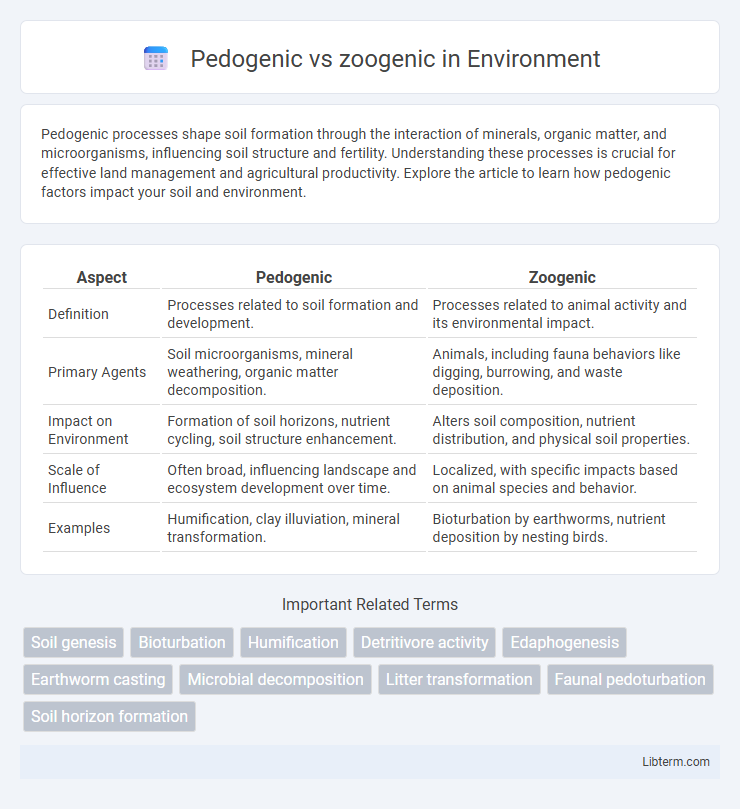Pedogenic processes shape soil formation through the interaction of minerals, organic matter, and microorganisms, influencing soil structure and fertility. Understanding these processes is crucial for effective land management and agricultural productivity. Explore the article to learn how pedogenic factors impact your soil and environment.
Table of Comparison
| Aspect | Pedogenic | Zoogenic |
|---|---|---|
| Definition | Processes related to soil formation and development. | Processes related to animal activity and its environmental impact. |
| Primary Agents | Soil microorganisms, mineral weathering, organic matter decomposition. | Animals, including fauna behaviors like digging, burrowing, and waste deposition. |
| Impact on Environment | Formation of soil horizons, nutrient cycling, soil structure enhancement. | Alters soil composition, nutrient distribution, and physical soil properties. |
| Scale of Influence | Often broad, influencing landscape and ecosystem development over time. | Localized, with specific impacts based on animal species and behavior. |
| Examples | Humification, clay illuviation, mineral transformation. | Bioturbation by earthworms, nutrient deposition by nesting birds. |
Introduction to Pedogenic and Zoogenic Processes
Pedogenic processes refer to the natural formation and development of soils through mineral weathering, organic matter accumulation, and horizon differentiation driven primarily by environmental factors such as climate, organisms, and topography. Zoogenic processes involve soil alterations created by the activity of animals, including burrowing, trampling, and organic matter redistribution, which significantly influence soil structure and nutrient cycling. Together, these processes interact to shape soil properties and ecosystem dynamics, highlighting the importance of both abiotic and biotic factors in soil genesis.
Defining Pedogenic: Soil Formation Mechanisms
Pedogenic processes refer to the natural mechanisms involved in soil formation, including weathering of parent rock, organic matter decomposition, and mineral transformation. These processes drive the development of soil horizons, structure, and nutrient cycling essential for ecosystem productivity. Pedogenesis contrasts with zoogenic influences, which primarily involve animal activities affecting soil properties.
Understanding Zoogenic: Animal Contributions to Soil
Zoogenic processes involve the direct influence of animals on soil formation through activities like burrowing, defecation, and decomposition, which enhance soil aeration and nutrient cycling. These animal contributions facilitate organic matter distribution and microbial activity, significantly impacting soil texture and fertility. Unlike pedogenic processes driven by abiotic factors, zoogenic influences emphasize bioturbation and nutrient input from fauna that improve soil structure and promote ecosystem productivity.
Key Differences Between Pedogenic and Zoogenic Processes
Pedogenic processes refer to soil formation mechanisms driven by physical, chemical, and biological factors within the soil environment, such as mineral weathering and organic matter decomposition. Zoogenic processes are influenced by animal activities, including bioturbation, nutrient cycling through excretion, and soil structure modification by burrowing organisms. Key differences lie in pedogenic processes primarily shaping soil properties through abiotic and microbial actions, while zoogenic processes involve direct animal contributions altering soil texture, nutrient distribution, and aeration.
Pedogenic Factors Influencing Soil Characteristics
Pedogenic factors influencing soil characteristics include parent material, climate, topography, organisms, and time, which collectively determine soil formation and properties. These factors control soil texture, structure, mineral content, organic matter, pH, and moisture retention, shaping fertility and ecosystem productivity. Pedogenesis contrasts with zoogenic processes, as it centers on abiotic and biotic soil formation drivers rather than animal-induced soil changes.
Zoogenic Influence on Soil Structure and Fertility
Zoogenic processes significantly enhance soil structure and fertility by promoting organic matter incorporation and nutrient cycling through the activities of soil fauna such as earthworms, termites, and ants. These organisms create biopores that improve aeration, water infiltration, and root penetration, while their waste products enrich the soil with essential nutrients and microbial communities. Zoogenic influence accelerates decomposition and humification, boosting soil porosity and nutrient availability, which are critical for sustainable soil productivity and ecosystem health.
Comparative Analysis: Pedogenic vs Zoogenic Soil Development
Pedogenic soil development results primarily from abiotic factors like mineral weathering, climate, and topography, leading to mineral-rich horizons and structured profiles. Zoogenic soil formation, driven by biological activity, especially from fauna such as earthworms and termites, enhances organic matter incorporation and nutrient cycling, promoting soil aggregation and porosity. Comparative analysis reveals pedogenic processes dominate in mineral transformation while zoogenic activity significantly influences soil bioturbation and organic matter distribution, both essential for sustainable soil fertility and ecosystem productivity.
Ecological Impacts of Pedogenic and Zoogenic Processes
Pedogenic processes, driven by soil formation and mineral weathering, significantly influence ecosystem productivity by regulating nutrient cycling and water retention capacity. Zoogenic activities, including animal burrowing and nutrient deposition through excreta, enhance soil aeration and organic matter distribution, promoting biodiversity and habitat complexity. Both pedogenic and zoogenic influences shape soil structure and fertility, directly affecting plant communities and overall ecological resilience.
Case Studies: Pedogenic and Zoogenic Interactions
Case studies reveal complex interactions between pedogenic and zoogenic processes, where soil formation is influenced by biological activities of organisms such as earthworms, termites, and large mammals. These interactions drive nutrient cycling, soil structure development, and organic matter distribution, significantly impacting ecosystem functions and soil fertility. Research highlights how zoogenic bioturbation enhances pedogenic horizons, creating heterogeneous microenvironments critical for sustaining biodiversity and soil health.
Conclusion: Integrating Pedogenic and Zoogenic Perspectives
Integrating pedogenic and zoogenic perspectives enhances understanding of soil formation by combining insights from abiotic processes and animal-driven bioturbation. This holistic approach reveals how both mineral weathering and faunal activity collaboratively influence soil structure, nutrient cycling, and ecosystem productivity. Leveraging both frameworks supports more accurate predictions of soil development and sustainable land management strategies.
Pedogenic Infographic

 libterm.com
libterm.com